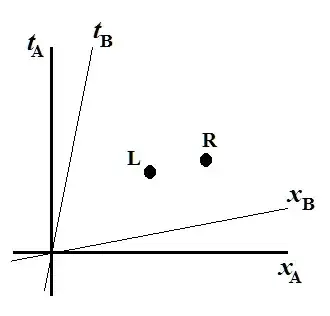I've been given the following scenario:
Observer $B$ is in the center of a train carriage which is moving at velocity $v$ with respect to an observer $A$. Two light signals are emitted from sources L at the left end and R at the right end of the carriage, such that they reach $B$ simultaneously. $B$ observes that the light signals were emitted at the same time. Show that $A$ doesn't agree.
What I've done so far is as follows:
Let the carriage be of length $2d$ from $A$'s point of view. Then the distance that light has travelled from the left is $d+v\Delta t_L=c\Delta t_L$. Similarly, the distance that light has travelled from the right to B is $d-v\Delta t_R=c\Delta t_R$. Can solve these to get $\Delta t_L=\dfrac{d}{c-v}$ and $\Delta t_R=\dfrac{d}{c+v}$. I'm OK with this.
In B's frame of refence, the two times $\Delta t'_L=\Delta t'_R$. Surely two equal time differences will dilate the same and we get that $\gamma \Delta t_L= \gamma \Delta t_R$ and thus $\Delta t_L=\Delta t_R$, which conradicts the above answer? I've been working on this for hours and it's completely inhibiting my progress.
Thanks for any replies!
